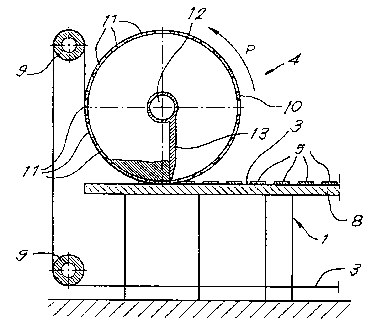Some of the information on this Web page has been provided by external sources. The Government of Canada is not responsible for the accuracy, reliability or currency of the information supplied by external sources. Users wishing to rely upon this information should consult directly with the source of the information. Content provided by external sources is not subject to official languages, privacy and accessibility requirements.
Any discrepancies in the text and image of the Claims and Abstract are due to differing posting times. Text of the Claims and Abstract are posted:
| (12) Patent: | (11) CA 2322358 |
|---|---|
| (54) English Title: | METHOD AND DEVICE FOR PRODUCING THIN PIECES OF CHOCOLATE |
| (54) French Title: | METHODE ET DISPOSITIF POUR PRODUIRE DE MINCES MORCEAUX DE CHOCOLAT |
| Status: | Term Expired - Post Grant Beyond Limit |
| (51) International Patent Classification (IPC): |
|
|---|---|
| (72) Inventors : |
|
| (73) Owners : |
|
| (71) Applicants : |
|
| (74) Agent: | ROBIC AGENCE PI S.E.C./ROBIC IP AGENCY LP |
| (74) Associate agent: | |
| (45) Issued: | 2006-01-24 |
| (22) Filed Date: | 2000-10-05 |
| (41) Open to Public Inspection: | 2001-12-14 |
| Examination requested: | 2003-05-15 |
| Availability of licence: | N/A |
| Dedicated to the Public: | N/A |
| (25) Language of filing: | English |
| Patent Cooperation Treaty (PCT): | No |
|---|
| (30) Application Priority Data: | ||||||
|---|---|---|---|---|---|---|
|
The present invention concerns a method for producing thin pieces of chocolate, in particular slices (5) of chocolate, whereby the chocolate is melted and is provided in the shape of flat, thin pieces of chocolate, one after the other, on at least one endless, flexible conveyor belt (3) of the conveying device (2), whereby said conveyor belt (3) is subsequently bent crosswise so that it forms a trough before the pieces have stiffened, and the conveyor belt (3) is kept in this bent position until the pieces lying in said trough and which are bent along with the conveyor belt (3) have sufficiently stiffened so as to keep their bent shape.
La présente invention concerne un procédé de production de morceaux fins de chocolat, en particulier des tuiles (5) de chocolat, par lequel le chocolat est fondu et acheminé sous forme de morceaux de chocolat fins et plats, les uns après les autres, sur au moins un tapis roulant flexible sans fin (3) d'un l'appareil de transport (2), sur lequel ledit tapis roulant (3) est ensuite courbé en travers pour former un creux avant que les morceaux durcissent, et le tapis roulant (3) est maintenu dans cette position courbée jusqu'à ce que les morceaux se trouvant dans ledit creux et qui sont courbés avec le tapis roulant (3) aient suffisamment durci pour garder leur forme courbée.
Note: Claims are shown in the official language in which they were submitted.
Note: Descriptions are shown in the official language in which they were submitted.

2024-08-01:As part of the Next Generation Patents (NGP) transition, the Canadian Patents Database (CPD) now contains a more detailed Event History, which replicates the Event Log of our new back-office solution.
Please note that "Inactive:" events refers to events no longer in use in our new back-office solution.
For a clearer understanding of the status of the application/patent presented on this page, the site Disclaimer , as well as the definitions for Patent , Event History , Maintenance Fee and Payment History should be consulted.
| Description | Date |
|---|---|
| Inactive: Expired (new Act pat) | 2020-10-05 |
| Common Representative Appointed | 2019-10-30 |
| Common Representative Appointed | 2019-10-30 |
| Change of Address or Method of Correspondence Request Received | 2018-12-04 |
| Inactive: Correspondence - MF | 2010-08-10 |
| Small Entity Declaration Request Received | 2009-07-20 |
| Small Entity Declaration Determined Compliant | 2009-07-20 |
| Inactive: IPC from MCD | 2006-03-12 |
| Inactive: IPC from MCD | 2006-03-12 |
| Inactive: IPC from MCD | 2006-03-12 |
| Grant by Issuance | 2006-01-24 |
| Inactive: Cover page published | 2006-01-23 |
| Inactive: Final fee received | 2005-11-09 |
| Pre-grant | 2005-11-09 |
| Notice of Allowance is Issued | 2005-07-29 |
| Notice of Allowance is Issued | 2005-07-29 |
| Letter Sent | 2005-07-29 |
| Inactive: Approved for allowance (AFA) | 2005-06-07 |
| Amendment Received - Voluntary Amendment | 2005-05-06 |
| Inactive: S.30(2) Rules - Examiner requisition | 2005-03-09 |
| Letter Sent | 2003-06-16 |
| Request for Examination Received | 2003-05-15 |
| Request for Examination Requirements Determined Compliant | 2003-05-15 |
| All Requirements for Examination Determined Compliant | 2003-05-15 |
| Application Published (Open to Public Inspection) | 2001-12-14 |
| Inactive: Cover page published | 2001-12-13 |
| Inactive: First IPC assigned | 2000-11-29 |
| Filing Requirements Determined Compliant | 2000-11-15 |
| Inactive: Filing certificate - No RFE (English) | 2000-11-15 |
| Application Received - Regular National | 2000-11-10 |
| Small Entity Declaration Determined Compliant | 2000-10-05 |
There is no abandonment history.
The last payment was received on 2005-07-28
Note : If the full payment has not been received on or before the date indicated, a further fee may be required which may be one of the following
Please refer to the CIPO Patent Fees web page to see all current fee amounts.
Note: Records showing the ownership history in alphabetical order.
| Current Owners on Record |
|---|
| JAN VAN DYCK |
| KRIS VAN DYCK |
| Past Owners on Record |
|---|
| None |